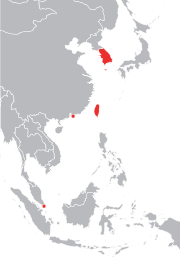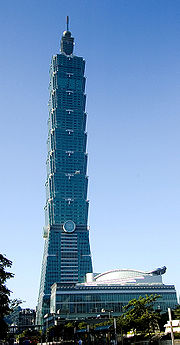Four Asian Tigers
| Four Asian Tigers | |||||||||||
|---|---|---|---|---|---|---|---|---|---|---|---|
 |
|||||||||||
| A map showing the Four Asian Tigers |
|||||||||||
| Chinese name | |||||||||||
| Traditional Chinese | 亞洲四小龍 | ||||||||||
| Simplified Chinese | 亚洲四小龙 | ||||||||||
| Literal meaning | Asia's Four Little Dragons | ||||||||||
|
|||||||||||
| Korean name | |||||||||||
| Hangul | 아시아의 네 마리 용 | ||||||||||
| Literal meaning | Asia's four dragons | ||||||||||
|
|||||||||||


The Four Asian Tigers or Asian Tigers are the highly developed economies of Hong Kong, Singapore, South Korea and Taiwan. These regions were the first newly industrialized countries, noted for maintaining exceptionally high growth rates and rapid industrialization between the early 1960s and 1990s. In the 21st century, all four regions have since graduated into advanced economies and high-income economies. These regions are still the world's fastest growing industrialized economies. However, attention has increasingly shifted to other Asian economies which are now experiencing faster economic transformation.
All four Asian Tigers have a highly educated and skilled workforce and have specialized in areas where they had a competitive advantage. For example, Hong Kong and Singapore became world leading international financial centres, while South Korea and Taiwan became world leaders in information technology. Their economic success stories became known as the Miracle on the Han River and the Taiwan Miracle and have served as role models for many developing countries,[1][2][3] especially the Tiger Cub Economies.
Contents |
Role of traditional philosophies
Economic success in Japan, followed by the Four Asian Tigers, has been attributed to the existence of harmonious labor-management relations (cf. W. Dean Kinzley, Industrial Harmony in Modern Japan: The Invention of a Tradition, Routledge, London & New York, 1991). “Industrial Harmony” is this unique “culture of harmony” that was consciously invented and developed over the last century in Japan. A semi-bureaucratic organization called the “Kyochokai” (The Co-operation and Harmony Society) was established in 1919 to meet the needs of an emerging industrial society. The Kyochokai took the lead in trying to define the values which would be suitable for a new Japanese-style industrial society, at the time of great social troubles in industrial Europe. The resulting "invented" tradition has played an important role in the evolution and character of Japanese economic values and behavior of social peace for economic development.[4]
Japanese experience appears to challenge unilinear theories of modernization, and to suggest that Japan’s uniqueness lies in the creation of its own kind of modernity, sharply divergent from that to be found in Western countries, and based paradoxically upon a reaffirmation of ancient Confucian values and native Japanese traditions of harmony, self-sacrifice and non-individualistic group striving in pursuit of a common cause. Japan’s emphasis on long-term growth, scrupulous market evaluation, and process engineering are all well regarded as important components of its economic development.
These "Asian values" are the foundations of the "Asian political economy". Abandoning import substitution, the model advocated in the developing world following the two world wars, the Four Asian Tigers pursued an export-driven model of economic development with the exportation of goods to highly-industrialized nations. Domestic consumption was discouraged through government policies such as high tariffs. The Four Asian Tigers singled out education as a means of improving productivity; these territories focused on improving the education system at all levels; heavy emphasis was placed on ensuring that all children attended elementary education and compulsory high school education. Money was also spent on improving the college and university system.
Since the Four Asian Tigers were relatively poor during the 1960s, these nations had an abundance of cheap labor. Coupled with educational reform, they were able to leverage this combination into a cheap, yet productive workforce. The Four Asian Tigers committed to egalitarianism in the form of land reform, to promote property rights and to ensure that agricultural workers would not become disgruntled. Also, policies of agricultural subsidies and tariffs on agricultural products were implemented as well.
These places had strong industrial economies which set them apart from all other places in Asia.
Territory and region data
Demographics
| Country or territory |
Area km² | Population | Population density per km² |
HDI (2007) | Capital |
|---|---|---|---|---|---|
| 1,104 | 7,026,400 | 6,349 | 0.944 | Hong Kong | |
| 705 | 4,987,600 | 7,023 | 0.944 | Singapore | |
| 99,678 | 49,773,145 | 487 | 0.937 | Seoul | |
| 36,188 | 23,131,093 | 639 | 0.943 | Taipei |
Economy
| Country or territory |
GDP nominal millions of USD (2009) |
GDP PPP millions of USD (2009) |
GDP nominal per capita USD (2009) |
GDP PPP per capita USD (2009) |
|---|---|---|---|---|
| 210,731 | 307,065 | 29,826 | 42,748 | |
| 177,132 | 238,755 | 37,293 | 50,523 | |
| 832,512 | 1,364,148 | 17,074 | 27,978 | |
| 378,969 | 735,997 | 16,392 | 31,834 |
Politics
| Country or territory |
Democracy Index (2008) |
Press Freedom Index (2009) |
Corruption Perceptions Index (2009) |
Political Status |
|---|---|---|---|---|
| 5.85 | 11.75 | 8.2 | Partially Democratic SAR | |
| 5.89 | 45.00 | 9.2 | Parliamentary Republic | |
| 8.01 | 15.67 | 5.5 | Presidential Republic | |
| 7.82 | 15.08 | 5.6 | Semi-Presidential Republic |
See also
- Economic miracle
- Taiwan Miracle
- Miracle on the Han River
- Anatolian Tigers
- Asian Century
- Baltic Tiger
- Celtic Tiger
- Greek economic miracle
- Japanese post-war economic miracle
- Miracle of Chile
- Nordic Tiger
- Gulf Tiger
- Spanish miracle
References
- ↑ "Can Africa really learn from Korea?". afrol News. 24 November 2008. http://www.afrol.com/articles/22953. Retrieved 2009-02-16.
- ↑ "Korea role model for Latin America: envoy". Korean Culture and Information Service. 1 March 2008. http://www.korea.net/news/news/newsView.asp?serial_no=20080301004&part=103. Retrieved 2009-02-16.
- ↑ Leea, Jinyong; LaPlacab, Peter; Rassekh, Farhad (2 September 2008). "Korean economic growth and marketing practice progress: A role model for economic growth of developing countries". Industrial Marketing Management (Elsevier B.V. (subscription required)). http://www.sciencedirect.com/science?_ob=ArticleURL&_udi=B6V69-4TR37CX-3&_user=10&_rdoc=1&_fmt=&_orig=search&_sort=d&view=c&_acct=C000050221&_version=1&_urlVersion=0&_userid=10&md5=5614827be8562007c3b0d6865ef92d15. Retrieved 2009-02-16.
- ↑ William Dean Kinzley (1991). Industrial Harmony in Modern Japan: The Invention of a Tradition. Routledge. ISBN 0415051673.
External links
- BBC report on the Asian Tigers in the aftermath of the 1997 Financial Crisis (includes map of the Asian Tigers)
- ASEAN tigers
- The Elephant at the Gate in China Economic Review
|
|||||
|
||||||||||||||||||||||||||||||||||||||
|
||||||||||||||||||||||||||||||||||
|
||||||||||||||||||||||||||||||||||||||
|
|||||||||||||||||||||||||||||||

.jpg)

